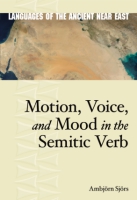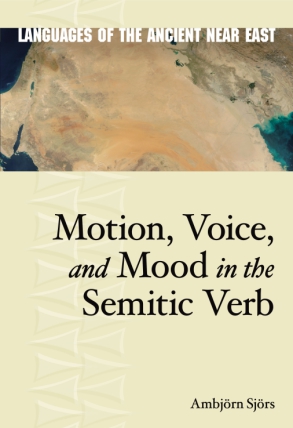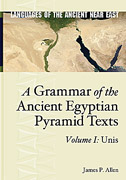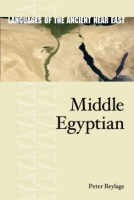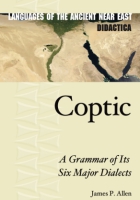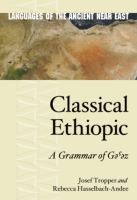Motion, Voice, and Mood in the Semitic Verb
Henning Ambjörn Sjörs
“Sjörs convincingly shows that we are dealing with a single morpheme (albeit with two allomorphs). That makes this book a must-read for all interested in comparative Semitic morphology, as well as a more than useful reference work for those studying the individual languages analyzed.”
- Description
- Reviews
- Bio
- Table of Contents
- Sample Chapters
Sjörs provides a systematic description of non-allative ventive verbs in Old Babylonian, the energic and volitive in Amarna Canaanite, the energic and lengthened prefix conjugation in Ugaritic, the lengthened imperfect consecutive in Biblical Hebrew, and the subjunctive and energic in Classical Arabic. Sjörs explains how these verb forms were used within the framework of grammaticalization theory and demonstrates how the suffixes are historically related.
Clearly and persuasively argued, Motion, Voice, and Mood in the Semitic Verb sheds valuable light on the Akkadian ventive and its relationship to the other related morphemes. It will be welcomed by linguists specializing in Akkadian, Amarna Canaanite, Ugaritic, Hebrew, and Arabic.
“Sjörs convincingly shows that we are dealing with a single morpheme (albeit with two allomorphs). That makes this book a must-read for all interested in comparative Semitic morphology, as well as a more than useful reference work for those studying the individual languages analyzed.”
“The formal connection of morphemes such as those between the Akkadian ventive and the Arabic energic has long been recognized, but a coherent description of the functional derivation has been lacking until now. Motion, Voice, and Mood in the Semitic Verb fills this gap in our understanding.”
Ambjörn Sjörs is a member of the Faculty of Asian and Middle Eastern Studies at the University of Cambridge and the author of Historical Aspects of Standard Negation in Semitic.
Preface
List of Abbreviations
Symbols and Transcriptions
Part 1: Introduction
Chapter 1. Preliminaries
1.1 Introduction
1.2 Scope and Material
1.3 Aim and Objectives
Chapter 2. Theoretical Prerequisites
2.1 The Ventive and the Allative
2.2 The Ventive and the Benefactive
2.3 The Reflexive-Benefactive and the Middle
Part 2: Analysis of the Material
Chapter 3. The Middle Ventive in Sargonic Akkadian and Literary Old Babylonian
3.1 Introduction
3.2 The Middle Ventive
3.3 Historical Background of the Ventive
3.4 Summary
Chapter 4. The Ventive-Energic in Amarna Canaanite
4.1 Introduction
4.2 The Ventive in -a
4.3 The Ventive in -n(n)a (the Energic)
4.4 Summary
Chapter 5. The Ventive-Energic in Ugaritic
5.1 Introduction
5.2. Morphological Aspects of the Ventive in Ugaritic
5.3. The Deictic Ventiv
5.4. The Middle Ventive
5.5. The Ventive in -a
5.6. The Compound Pronominal Suffix -n /-Vnnū\ā/
5.7. Plural Verb Forms
5.8. Summary
Chapter 6. The Ventive-Energic in Biblical Hebrew
6.1. Introduction
6.2. The Ventive and the Lengthened Imperfect Consecutive
6.3. The Ventive with Pronominal Suffixes
6.4. The Ventive Allomorph -nå̄
6.5. The Ventive of 2nd and 3rd Person Verb Forms
6.6. Equivocal Examples
6.7. Summary
Chapter 7. The Ventive in Prestandardized Classical Arabic I: The Energic
7.1. Introduction
7.2. The Relationship Between the Long and Short Energic
7.3. Functions of the Energic
7.4. Historical Background of the Energic
7.5. Summary
Chapter 8. The Ventive in Prestandardized Classical Arabic II: The Subjunctive
8.1. Introduction
8.2. The Subjunctive after fa-, ʔaw, and ḥattā
8.3. The Subjunctive after ʔan
8.4. The Subjunctive after lan
8.5. The Subjunctive after li- and kay
8.6. Historical Background of the Subjunctive
8.7. Summary
Part 3: Summary and Conclusions
Chapter 9. Morphological Aspects of the Ventive Morpheme
9.1 The Morpheme *-an in Central Semitic
9.2. The Morpheme *-nVn in Central Semitic
9.3. The Ventive in Proto-Semitic
Chapter 10. Functional Aspects of the Ventive Morpheme
10.1. The Allative and Dative Ventive
10.2. The Benefactive Ventive
10.3. The Middle Ventive
Bibliography
Ancient Source Index
Download a PDF sample chapter here: Introduction
Also of Interest
Mailing List
Subscribe to our mailing list and be notified about new titles, journals and catalogs.
